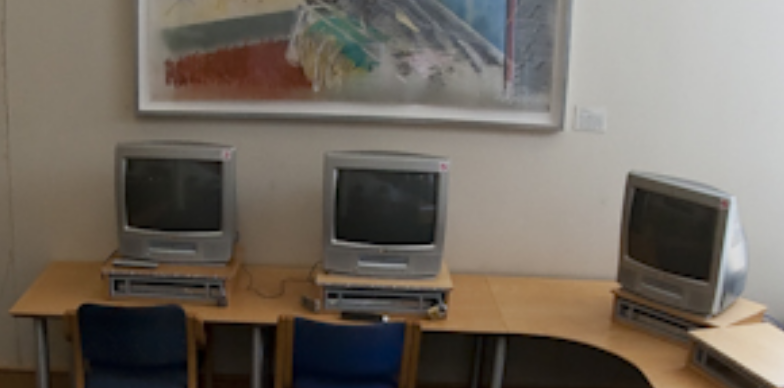Fragments of the African Film Collection Survived the Fire

Initially believed to be entirely destroyed by fire, the AV team has recovered at least 850 titles of the original African Studies Film Collection. They were kept in VHS format and have now been digitised.
In the Before Times, right at the back of the Reading Room was a TV. It’s barely visible in photographs of the Reading Room, but it was there, right next to one of the photocopiers. That TV was important because the new computers we got just before the lockdown did not have DVD drives.

It was one of those TVs with an in-built VCR (that’s a Video Cassette Recorder) and we had a DVD player there as well. If you wanted to watch something from the African Film Collection, and your laptop didn’t have a DVD drive, you would need to use that TV.

The African Film Collection was widely recognised as one of the premier collections of African Film in the world. Bev’s List, formally known as the Guide to the African Studies Film Collection, eventually got to be too unwieldy for MS Word, and, in order to ensure that the most up-to-date version was always available, the contents were moved to Google Docs. The size was also a problem there, so the list was split up alphabetically. Many of these titles were hard to find, with the only known copy being in the Jagger Library’s DVD Room. The Collection held around 3500 titles on DVDs, including published films and recordings of UCT productions.
And then the fire. The pictures still make me feel sick. At first we thought everything was gone. Then we knew some things had survived. But what? The bright orange seen through the windows, the smoke billowing into the sky suggested that the upper levels were gone. The DVD Room was on the same level as the staff space, the gallery overlooking the Reading Room. (Bev talks about her hopes that the DVD Room survived here)

Every shift at the reference desk involved at least one trip to the DVD Room, often more. It would have been more convenient for the DVD Room to be behind the heavy doors at the back of the Reading Room, in the little room where items awaiting cataloguing were kept. If I were in charge, I probably would have swapped the contents of those rooms. It would be more convenient to also have the cataloguing closer to the staff workspaces. The little room at the back was probably too small to house the entire African Film Collection, but the cataloguing backlog was constantly overflowing anyway, so it wouldn’t have made that much of a difference.
Except, that area mostly escaped the fire and the DVD Room did not.

The destruction of the African Film Collection was total.
Or was it?

In the lowest basement lived the Audiovisual Archive. Before I was recalibrated to Primary Collections at the end of 2017, Bev watched over it. I spent a lot of time wandering up and down the ramps and stairs between my desk and the lowest basement. And the fire didn’t get into the Interspace. The fire didn’t go down the ramps. The AV Archive survived. We know now that it survived surprisingly well and in surprisingly good condition.
But in the first couple of days after the fire the news was not so good. The basement was flooded with all the water used to douse the flames, any chemical fire retardants that were used, ash, and sediment. It was dark in the basement even when the lights were on. (No, I never pretended to be an adventurer spelunking through caves after hidden treasures, why would you ask that?) It was impenetrable blackness without the lights. And the ramp led down into a lake that was waist-high on average-sized people. The bottom shelves were submerged.

On the other end of the basement, there were stairs. And in the compactus beside the stairs, were the African Studies VHS tapes. Back when Sue Ogterop started the African Film Collection, VHS was the medium of choice. Eventually, the tapes were phased out in favour of DVDs. But what to do with the old tapes? The obvious answer was to convert them to DVD so that they could be easily accessed by users. UCT TV did the conversion (the Libraries did not have digitisation facilities back then). On legal advice, however, the old VHS tapes were kept. Shelved in the basement and mostly forgotten. Initial estimates were that there was maybe a tenth of the collection still on VHS.

AV material does not like water. Damp conditions lead to mould and warping and rust and all sorts of other problems. So the lowest basement was salvaged first. Some material was triaged and sent to cold storage. There may be more African Film Collection VHS tapes in there. I don’t know. There are at least 29 crates of African Film Collection VHS tapes that were salvaged. You can fit a lot of VHS tapes in 29 crates. I don’t know how many tapes there are, because there are duplicates, but there are around 850 titles. That’s nearly a quarter of the collection!
Much unique material has been lost and will never be recovered, however the VHS tapes represent some of the older works in the Collection. Along with the AV Archives these tapes formed part of a digitisation preservation project that was outsourced to VRTV in 2022 (read more: here, here, and here). It may not have everything it used to have, but the African Film Collection will arise from the ashes as an e-film collection, DVDs now being a mostly obsolete format, and these old VHS tapes will be the foundation of it.
